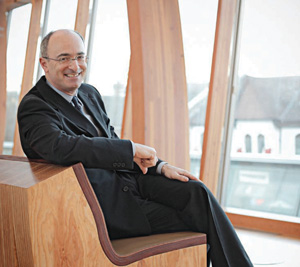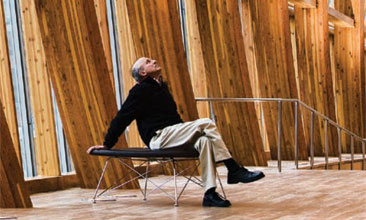What makes great art is an ongoing subject for debate, but according to Matthew Teitelbaum, the Art Gallery of Ontario’s director and CEO, “exceptional art needs to emanate beauty or a sense of pleasure and at the same time empowers one to think differently about the world.”
Under Teitelbaum’s leadership, the AGO, situated in the heart of Toronto’s downtown Grange Park district, has come to embody an aesthetic beauty, powerfully visible in the spectacular $276 million redesign known as Transformation AGO (it was conceived and created by renowned architect Toronto-born Frank Gehry). Since it reopened in 2008, Teitelbaum is confident that the AGO has evolved into an institution “that responds to the very specific needs of the audiences,” welcoming millions of visitors. But at the very core of the AGO’s success is Teitelbaum’s solid vision and uncompromising dedication to making the AGO an institution that serves its community.
Seated at a round table in a simple meeting room, Teitelbaum, 56, stirs his tea while looking patiently through his rimless glasses. Wearing a conservative gray suit and skinny tie, he speaks softly, making every word count. Teitelbaum has been the Michael and Sonja Koerner Director and CEO of the AGO, one of Canada’s largest and most important museums, since 1998. Given his accomplishments, Teitelbaum could be intimidating, yet it takes only a few minutes to realize that he has an active and dry humorous side, and infuses witty one-liners throughout his conversation. His impressive and lengthy CV is intimidating, but Teitelbaum has an easy way with people, and quite naturally blends that with an enthusiasm for the gallery and its world-class exhibitions.
Romeo, a member of the Protection Services Officers team, one of the smartly dressed men and women standing guard over the gallery, is grateful that his boss of over 20 years is a “smiley and all-around good guy.” Chelly, another longtime PSO, appreciates Teitelbaum’s humble nature, and feels challenged at work, proudly citing a high expectation of being knowledgeable about the art exhibited, the artists, and the design of the recently renovated building.
As if the director were paying per compliment, Caitlin Coull, manager of communications at AGO, joins in the Teitelbaum lovefest, explaining how he is readily available to staff and volunteers at the regular Town Hall meetings.
The museum’s unique collaborative work environment doesn’t hurt, either. “It’s impossible not to be excited about what we do,” Teitelbaum says. “I feel that I’m part of the process that is bringing wonderful exhibitions and experiences to members and visitors.”
He is quick to point out that the AGO’s success is in large part a result of great volunteer leadership and an influential board of directors who “wanted to make a difference in their city of Toronto” by launching the Transformation AGO project back in 2004, with the support of the Canadian government, the Province of Ontario, and some major benefactors.
The list starts with media giant Kenneth Thomson, who, before his death in 2006, donated close to 2,000 works from his private European and Canadian art collection (estimated to be worth hundreds of millions of dollars) in addition to a cash gift of approximately $100 million. When Thomson expressed an interest in commissioning Gehry to undertake the massive renovation, although Teitelbaum had never met Guggenheim Museum Bilbao in Spain and some of his other architectural wonders, and “loved” the way he felt when moving through the spaces (he refers to the experience as a kind of “sensual journey”).
Teitelbaum wanted AGO visitors to indulge in a similar experiential odyssey. On a midsummer morning, yoga lovers were striking warrior poses surrounded by 900 of Henry Moore’s sculptures and works. Later, a passionate gallery guide discussed the intent of Dutch painter Hendrick Andriessen’s still-life piece while, a few floors up, a school group of 7-year-olds tweeted their answers to questions posed by Canadian artist Iain Baxter& in a Wi-Fi-friendly gallery space.
One thing’s for certain: The new AGO isn’t your grandpa’s art gallery. Boosted by Thomson’s generous gift, the AGO now has a permanent collection of more than 80,000 works, including an outstanding collection of Canadian art, as well as the largest collection of African and Oceanic art found in a Canadian art museum.
Murray Frum, the main donor to both collections, calls Teitelbaum a “visionary” because of his ability to connect with collectors, to know what they’re col lecting, and, in the process, to discover a possible fit with the museum. Frum also applauds Teitelbaum for “going out of his way to involve the community” by making them feel like a vital part in the decision making at the AGO. Teitelbaum thoroughly enjoys working with patrons like Frum and supercollectors like Joey and Toby Tanenbaum, admiring them for their “passion, competitiveness, and focus.” He sees collectors as “storytellers” who create a narrative about an idea through the objects they possess.
“There’s a constant living education, a commitment to an object, and a willingness to learn from an object, which is all very exciting,” Teitelbaum says.
 Teitelbaum trusts that peoples’ imaginations are being unlocked when they visit the AGO, with most of the 110 galleries dedicated to theme rather than chronology, allowing gallery-goers to grasp the concepts behind the art and the motivation of the artists. You don’t have to be an AGO member to enjoy the myriad of free and affordable programming for all ages, which includes gallery tours, lectures, workshops, and film screenings. A recent initiative, the artist-in-residence program in the Weston Family Learning Centre, gives new artists a platform to connect with visitors.
Teitelbaum trusts that peoples’ imaginations are being unlocked when they visit the AGO, with most of the 110 galleries dedicated to theme rather than chronology, allowing gallery-goers to grasp the concepts behind the art and the motivation of the artists. You don’t have to be an AGO member to enjoy the myriad of free and affordable programming for all ages, which includes gallery tours, lectures, workshops, and film screenings. A recent initiative, the artist-in-residence program in the Weston Family Learning Centre, gives new artists a platform to connect with visitors.
So, how does someone grow up to become an expert in all things art?
Teitelbaum’s commitment to making art accessible for a diverse population can be traced back to being raised in a socially minded Toronto family. Teitelbaum’s father, Mashel, was an artist, whose paintings leaned on most of the walls of the family’s Yonge-St. Clair area home. Regular dinner conversations often turned into lively political discussions with his father and his mother, Ethel, a tribunal member at the Immigration and Refugee Board for over 20 years.
Teitelbaum acknowledges the family’s sacrifices to accommodate Mashel’s unusual working hours. “So the idea that art was something to be exalted and separate from the way you live was impossible for me to conceive,” he offers.
As Teitelbaum was never inclined to be an artist, talks with his father were more about writers than the world of art. Ironically, Teitelbaum would often hear his father lament that “no one should be an artist who doesn’t have to be,” reflecting on the difficult life and commitment that goes along with being an artist. In the early 1980s, Mashel was known to picket outside the AGO because he felt the institution as a whole was out of touch with artists. Mashel’s anti-institutional inclinations inadvertently helped guide Teitelbaum throughout his career.
“I’ve always held onto my father’s skepticism as a personal challenge to ensure that large institutions are more relevant and responsive to artists.”
After earning an M.Phil. in modern European painting and sculpture at the acclaimed Courtauld Institute of Art in London, and before signing on as chief curator at the AGO in 1993, Teitelbaum held curatorial positions at the Institute of Contemporary Art in Boston, the Mendel Art Gallery in Saskatoon, and, earlier in his career, at the London Regional Art Gallery in Ontario. In addition, he received the honor of Chevalier des Arts et des Lettres from the French government and was awarded an honorary Doctor of Laws from Queen’s University in Ontario.
Although Teitelbaum never envisioned a life in academics, preferring to work directly with artists, he has lectured at Harvard University as well as other universities across North America. When Teitelbaum returned home to Toronto in the early 1990s with his wife, Susan Cohen, and their two young sons, Elijah and Max, he felt strongly connected to the city and the art gallery he had regularly visited as a child. He soon realized that what he wanted most of all was to have an art institution that was important to people.
“From the moment I started working in museums,” he admits, “I’ve loved it. I love the idea of being an advocate, I love the idea of being in an interface with the public, and I love the idea of creating an audience.”
The Art Gallery of Ontario’s current show is entitled Frida & Diego: Passion, Politics and Painting. It runs from October 20, 2012, through January 20, 2013.
> This article by Rena Godfrey appeared in Lifestyles Magazine.
